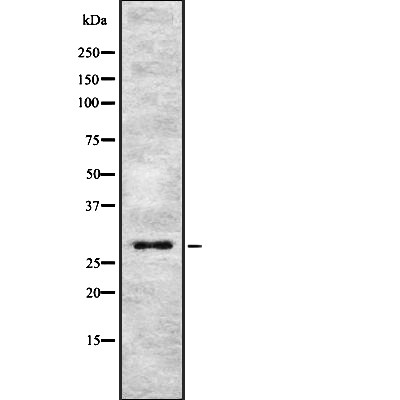APOD Antibody - #DF7987
| Product: | APOD Antibody |
| Catalog: | DF7987 |
| Description: | Rabbit polyclonal antibody to APOD |
| Application: | WB IF/ICC |
| Cited expt.: | IF/ICC |
| Reactivity: | Human, Mouse, Rat |
| Mol.Wt.: | 30 kDa; 21kD(Calculated). |
| Uniprot: | P05090 |
| RRID: | AB_2841371 |
Related Downloads
Protocols
Product Info
*The optimal dilutions should be determined by the end user. For optimal experimental results, antibody reuse is not recommended.
*Tips:
WB: For western blot detection of denatured protein samples. IHC: For immunohistochemical detection of paraffin sections (IHC-p) or frozen sections (IHC-f) of tissue samples. IF/ICC: For immunofluorescence detection of cell samples. ELISA(peptide): For ELISA detection of antigenic peptide.
Cite Format: Affinity Biosciences Cat# DF7987, RRID:AB_2841371.
Fold/Unfold
APO D; Apo-D; ApoD; APOD protein; APOD_HUMAN; Apolipoprotein D; ApolipoproteinD;
Immunogens
A synthesized peptide derived from human APOD, corresponding to a region within the internal amino acids.
Expressed in liver, intestine, pancreas, kidney, placenta, adrenal, spleen, fetal brain tissue and tears.
- P05090 APOD_HUMAN:
- Protein BLAST With
- NCBI/
- ExPASy/
- Uniprot
MVMLLLLLSALAGLFGAAEGQAFHLGKCPNPPVQENFDVNKYLGRWYEIEKIPTTFENGRCIQANYSLMENGKIKVLNQELRADGTVNQIEGEATPVNLTEPAKLEVKFSWFMPSAPYWILATDYENYALVYSCTCIIQLFHVDFAWILARNPNLPPETVDSLKNILTSNNIDVKKMTVTDQVNCPKLS
Research Backgrounds
APOD occurs in the macromolecular complex with lecithin-cholesterol acyltransferase. It is probably involved in the transport and binding of bilin. Appears to be able to transport a variety of ligands in a number of different contexts.
N-glycosylatd. N-glycan heterogeneity at Asn-65: Hex5HexNAc4 (major) and Hex6HexNAc5 (minor); at Asn-98: Hex5HexNAc4 (minor), dHex1Hex5HexNAc4 (major), dHex1Hex6HexNAc5 (minor) and dHex1Hex7HexNAc6 (minor).
Secreted.
Expressed in liver, intestine, pancreas, kidney, placenta, adrenal, spleen, fetal brain tissue and tears.
Belongs to the calycin superfamily. Lipocalin family.
References
Application: IF/ICC Species: Mouse Sample: articular cartilage
Restrictive clause
Affinity Biosciences tests all products strictly. Citations are provided as a resource for additional applications that have not been validated by Affinity Biosciences. Please choose the appropriate format for each application and consult Materials and Methods sections for additional details about the use of any product in these publications.
For Research Use Only.
Not for use in diagnostic or therapeutic procedures. Not for resale. Not for distribution without written consent. Affinity Biosciences will not be held responsible for patent infringement or other violations that may occur with the use of our products. Affinity Biosciences, Affinity Biosciences Logo and all other trademarks are the property of Affinity Biosciences LTD.


